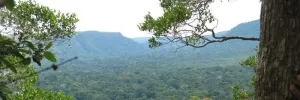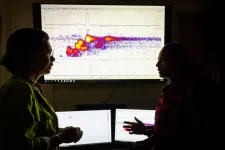(Press-News.org) Bronx, NY—In the global effort to combat climate change, large-scale, plant-based strategies such as planting forests and cultivating biofuels are an increasingly important part of countries’ plans to reduce their overall carbon emissions, but a landmark new study in the journal Science finds that well-intended strategies could have unforeseen impacts on biodiversity and that, in general, restoring forests has the most beneficial effect on wildlife.
The authors, including New York Botanical Garden (NYBG) Assistant Curator Evelyn Beaury, Ph.D., argue that policy makers and conservation officials should consider impacts on biodiversity when evaluating the most effective tools to mitigate climate change.
“As efforts to address climate change accelerate, it is urgent to ensure that in deploying LBMS we do not inadvertently imperil biodiversity,” Dr. Beaury and her colleagues write, using the acronym for land-based mitigation strategies, which use plants to store carbon.
Dr. Beaury is an Assistant Curator in NYBG’s Center for Conservation and Restoration Ecology, which is working to expand NYBG’s collaborations with conservation initiatives worldwide; strengthen conservation capacity building, including training future biodiversity leaders; and advance conservation by fostering the sustainable use of plant resources locally and globally.
Many net-zero emissions plans call for implementing plant-based mitigation strategies across millions of acres of land. The most common approaches are reforestation (restoring forests in places where they have historically grown), afforestation (adding forests in places like savannahs and grasslands), and bioenergy cropping (farming plants such as switchgrass for renewable energy). Until now, it has been challenging to predict these strategies’ impacts on biodiversity because they affect species in multiple, complex ways.
The new study, published online and in the print edition of this week’s Science, is the first of its kind to evaluate the potential biodiversity impacts of those three climate change mitigation strategies globally. The team of scientists—led by Dr. Jeffrey Smith, Ph.D., an Associate Research Scholar at Princeton University’s High Meadows Environmental Institute—modeled the impact of these mitigation strategies on over 14,000 animal species, from creatures smaller than a mouse to larger than a moose.
Most countries worldwide, from Austria to Zimbabwe, have committed to using these methods to reach their climate targets. However, as Dr. Beaury notes: “Plant-based mitigation strategies do not have the same effect on the climate or on biodiversity everywhere they are deployed. Our research suggests that we cannot assume plant-based solutions always indirectly reduce the biodiversity crisis.”
The team of scientists—which also included Jonathan Levine, Ph.D., Professor of Ecology and Evolutionary Biology at Princeton, and Susan C. Cook-Patton, Ph.D., Senior Forest Restoration Scientist at The Nature Conservancy—found that reforestation will benefit many species both locally, by increasing habitat, and globally, by mitigating climate change. These include many iconic forest species from spotted salamanders and red-bellied woodpeckers to jaguars.
The outcomes for planting monocultures of bioenergy crops or converting natural savannahs and grasslands to forests are not as rosy. While these efforts may help address climate change and reduce climate threats to biodiversity, they will also lead to immediate habitat loss. Replacing biodiverse meadows with bioenergy crops would be hugely detrimental for species from grouse to elk. Similarly, converting savannahs to forests would lead to the decline of iconic species such as ostriches and lions. The study found that the loss of habitat due to afforestation and bioenergy would be far greater than the benefit they would provide to biodiversity by helping mitigate climate change globally.
While ecologists have long suspected that some of these interventions would mean less habitat for wildlife, this study provides the first quantitative assessment of the potential impacts. “Reforestation is an obvious ‘win-win’ for biodiversity,” said Dr. Beaury, an ecologist and biogeographer whose expertise includes invasive plants. “Restoring lost forest provides habitat as well as reduces the impacts of climate change.”
“Variable impacts of land-based climate mitigation on habitat area for vertebrate diversity” is available at the following link: https://www.science.org/doi/10.1126/science.adm9485
About The New York Botanical Garden
The New York Botanical Garden (NYBG) has been a connective hub among people, plants, and the shared planet since 1891. For more than 130 years, NYBG has been rooted in the cultural fabric of New York City, in the heart of the Bronx, its greenest borough. NYBG has invited millions of visitors to make the Garden a part of their lives, exploring the joy, beauty, and respite of nature. NYBG’s 250 acres are home to renowned exhibitions, immersive botanical experiences, art and music, and events with some of the most influential figures in plant and fungal science, horticulture, and the humanities. NYBG is also a steward of globally significant research collections, from the LuEsther T. Mertz Library collection to the plant and fungal specimens in the William and Lynda Steere Herbarium, the largest such collection in the Western Hemisphere.
The plant people of NYBG—dedicated horticulturists, enthusiastic educators, and scientific adventurers—are committed to helping nature thrive so that humanity can thrive. They believe in their ability to make things better, teaching tens of thousands of kids and families each year about the importance of safeguarding the environment and healthy eating. Expert scientists work across the city, the nation, and the globe to document the plants and fungi of the world—and find actionable, nature-based solutions to the planet’s dual climate and biodiversity crises. With eyes always looking forward, they train the next generation of botanists, gardeners, landscape designers, and environmental stewards, ensuring a green future for all. At NYBG, it’s nature—or nowhere.
###
END
A new statistical tool that combines multiple clinical and pathologic factors with a patient's 21-gene Oncotype DX Breast Recurrence Score® result provides more accurate estimates about that patient’s breast cancer prognosis and their potential benefit from chemotherapy than either the Recurrence Score® result or clinical factors alone.
The tool could be used in counseling patients with hormone receptor-positive (HR+), HER2-negative breast cancer that has spread to the lymph nodes, and could improve shared decision-making ...
Chirality refers to objects that cannot be superimposed to their mirror images through any combination of rotations or translations, much like the distinct left and right hands of a human. In chiral crystals, the spatial arrangement of atoms confers a specific "handedness", which, for example, influences their optical and electrical properties.
The Hamburg-Oxford team focused on so-called antiferro-chirals, a type of non-chiral crystals reminiscent of antiferro-magnetic materials, in which magnetic ...
By definition, robots can’t feel empathy — it requires being able to relate to another person’s human experience, to put yourself in their shoes.
But according to new U of T Scarborough research, artificial intelligence (AI) can create empathetic responses more reliably and consistently than humans, even when compared to professionals whose job relies on empathizing with those in need.
“AI doesn’t get tired,” says Dariya Ovsyannikova (HBSc 2023 UTSC), lab manager in Professor Michael Inzlicht’s lab at U of T Scarborough ...
Quantum dots are tiny semiconductor nano materials with color-tunable and high-efficiency photoluminescence, which have been successfully applied in different display technology such as liquid crystal displays (LCDs), organic light-emitting diodes (OLEDs), and micro light-emitting diodes (Micro-LEDs). In 2023, the Nobel Prize in Chemistry rewards the discovery and development of quantum dots. Perovskite quantum dots (PQDs) are emerging display materials with high absorption coefficient, low cost and easy processability, and less environmental impact. ...
Researchers at Rutgers University have found that adverse childhood experiences can make people more sensitive to potential threats from others, which in turn increases their risk of engaging in defensive gun use in adulthood.
Their study, published in the Journal of Psychiatric Research, used cross-sectional data from a subsample of 3,130 adults with firearm access drawn from a nationally representative sample of U.S. adults.
Those surveyed were asked about their childhood experiences with abuse and neglect, their levels of social distrust and sensitivity to perceived threats, depressive symptoms and their self-reported use of a gun for self-defense.
The authors first assessed the association ...
BUFFALO, N.Y. — In the quest to take the “forever” out of “forever chemicals,” bacteria might be our ally.
Most remediation of per- and polyfluoroalkyl substances (PFAS) involves adsorbing and trapping them, but certain microbes can actually break apart the strong chemical bonds that allow these chemicals to persist for so long in the environment.
Now, a University at Buffalo-led team has identified a strain of bacteria that can break down and transform at least three types of PFAS, and, perhaps even more crucially, some of ...
Researchers have measured the thinking time of London taxi drivers - famous for their knowledge of more than 26,000 streets across the city - as part of a study into the future of AI route-mapping.
Unlike a satnav, which calculates every possible route until it gets to the destination, researchers at the University of York, in collaboration with University College London and the Champalimaud Foundation, found that London taxi drivers rationally plan each route by prioritising the most challenging areas first and filling in the rest of the route around these tricky points.
Current computational models to understand ...
Rising carbon dioxide levels affect more than just the climate; they also affect the chemistry of the oceans. When saltwater absorbs carbon dioxide, it becomes acidic, which alters the aquatic animal ecosystem. But how exactly does ocean acidification impact animals whose genetic makeup can shift depending on environmental cues? A study published in ACS’ Environmental Science & Technology addresses this question through the “eyes” of oysters.
Oysters, unlike mammals and birds, do not have chromosomes that dictate their sex at the ...
Images
More than a third of Detroit residents (36%) can't get from place to place in a safe or timely manner.
This is the main finding of a new study led by Alexandra Murphy, associate director of social science research at Mcity and assistant research scientist at U-M's Poverty Solutions, and first author Lydia Wileden, a U-M alum and assistant research professor at the University of Connecticut.
They measured this with a tool created by Murphy and her team called the Transportation Security ...
Researchers led by electrical engineers at the University of California San Diego have developed a better way to perform the comparative analysis of entire genomes. This approach can be used to study relationships between different species across geological time scales.
This new approach is poised to unlock discoveries regarding how evolution has shaped present-day genomes and also how the tree of life is organized. The new method, named CASTER, is described in a paper published in Science on 23 January 2025.
CASTER ...




